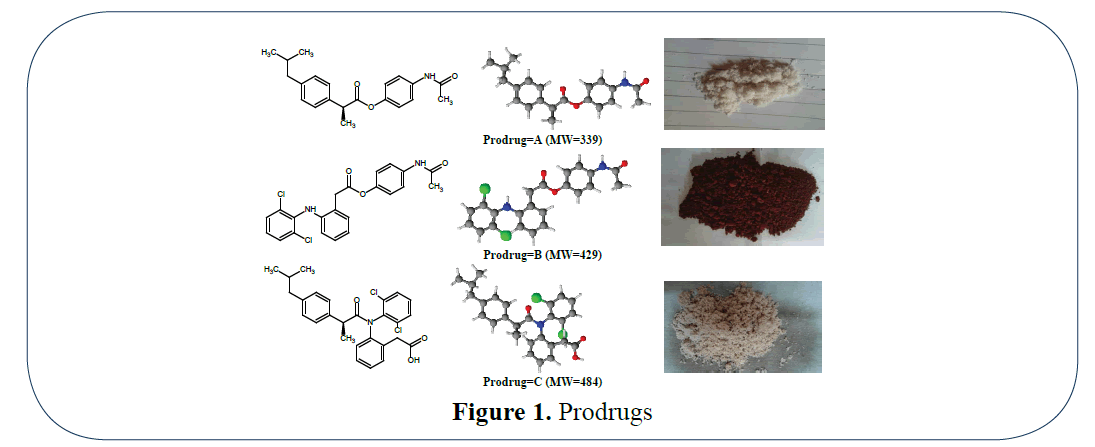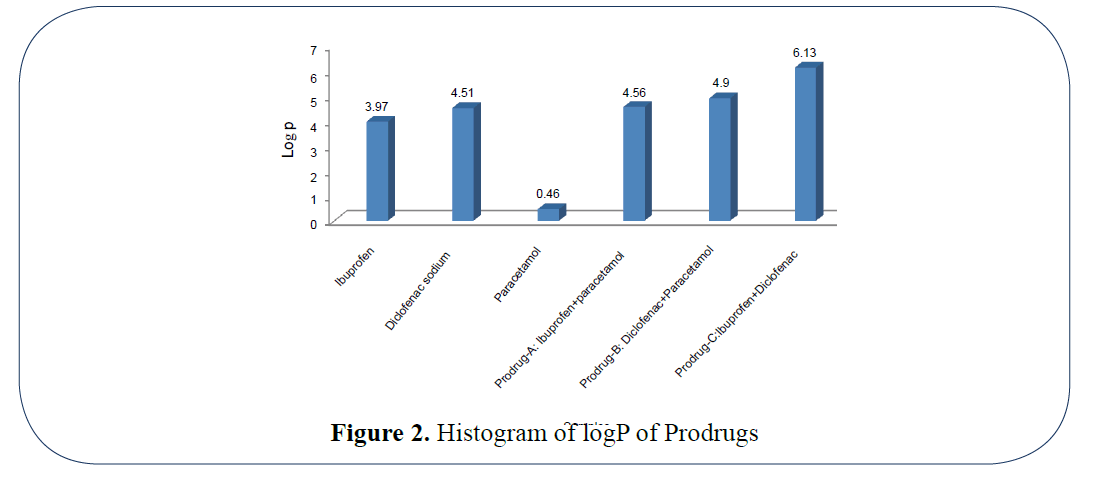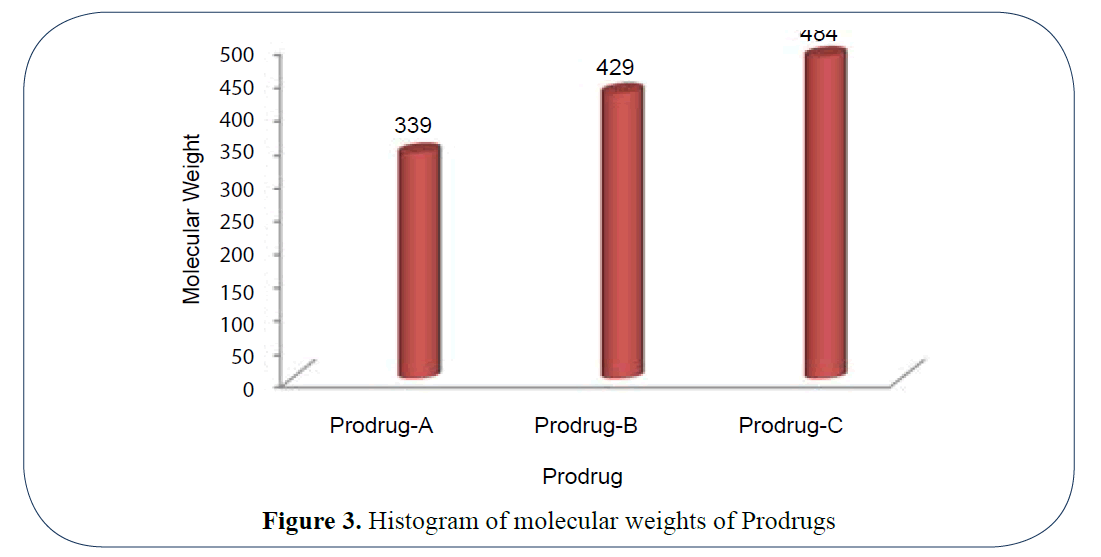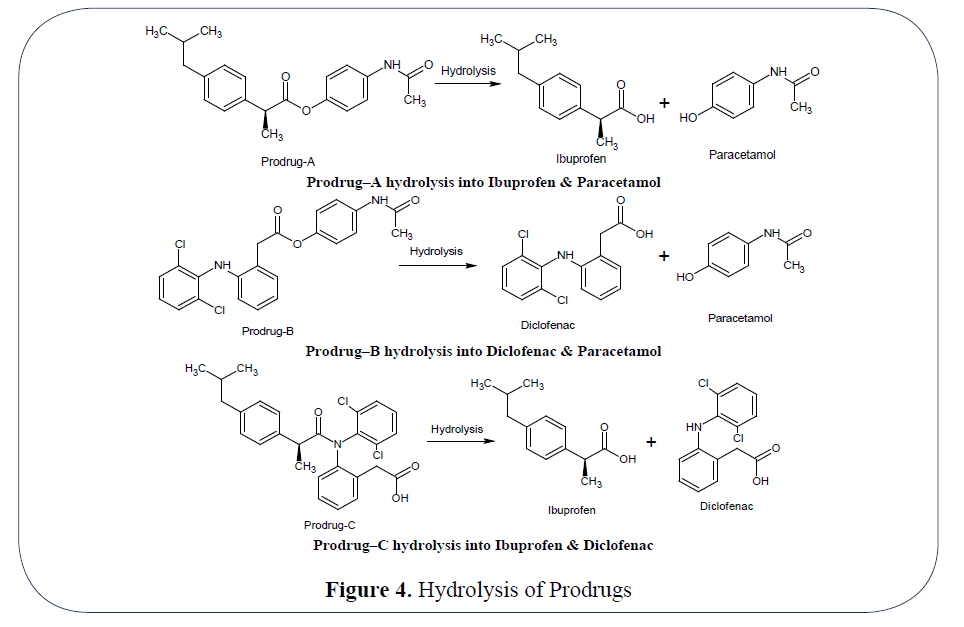Keywords
Ibuprofen, Diclofenac sodium, Paracetamol, Thionyl chloride, logP, pKa, Melting Point, Prodrug
Introduction
Three prodrugs (Prodrug-A, Prodrug-B and Prodrug-C) have been successfully synthesized and have shown different melting points from individual parent drugs (Ibuprofen, Diclofenac sodium and Paracetamol) which indicates the authenticity of fulfillment of prodrug synthesis [1,2]. The synthesized prodrugs were characterized by MP, logP values and IR (Infrared) spectrum for structural authentification. Their solubility parameters also found different from parent drugs. Prodrug is a substance having no medicinal importance but after biotransformation in GIT it releases the parent drug which is able to show the pharmacological activity [3-5].
Ibuprofen [C13H18O2; MW=206] (2-[4-(2-methylpropyl) phenyl]propanoic acid), from isobutylphenylpropanoic acid, is a drug in the nonsteroidal anti– inflammatory drug (NSAID) class used for treating pain, fever and inflammation. logP=3.97, pKa=4.91. Ibuprofen m.p.=theoretical (76°C), practical (75°C).
Diclofenac sodium [NaC14H10Cl2NO; MW=302] (Sodium {2-[(2,6-dichlorophenyl) amino]phenyl}acetic acetate) is a nonsteroidal anti–inflammatory drug (NSAID) taken or applied to reduce inflammation and as an analgesic reducing pain in certain conditions. logP=4.51, pKa=4.15. Diclofenac sodium m.p.=theoretical (283-285°C), practical (282°C) Paracetamol [C8H9NO2; MW=151] (N–(4– hydroxyphenyl)acetamide), also known as acetaminophen or APAP, is a medication used to treat pain and fever. logP=0.46, pKa=9.38. Paracetamol m.p.=theoretical (169°C), practical (170°C) (Figure 1).
Ibuprofen, Diclofenac and Paracetamol all comes under NSAID and all three are acidic in nature. Ibuprofen and diclofenac both have free carboxylic acid (–COOH) group and paracetamol has free phenolic group (–OH). The idea of formation of prodrug by joining of free carboxylic acid (–COOH) group of ibuprofen and diclofenac with phenolic group (–OH) of paracetamol by converting free carboxylic acid (–COOH) group into acid chloride (–COCl) and conjugated with free phenolic group (–OH) by benzoylation reaction to get the three desired compounds [Prodrug-A and Prodrug-B having ester (–COO–) linkage. Acid chloride (–COCl) of ibuprofen when reacts with imino group (– NH) of diclofenac then it produces Prodrug–C having amide (–CONH–) linkage (Figure 2) [6].
Figure 2: Histogram of logP of Prodrugs
Chemistry
Ibuprofen (2 g, 0.01 m) has been reacted with 5 ml thionyl chloride and refluxed for 30 mins in moisture free environment until all ibuprofen has been dissolved. The reaction mixture was heated on water bath to remove excess thionyl chloride. It was then cooled in ice and paracetamol (1.5 g, 0.01 m) dissolved in methanol was added in it with shaking. Oily droplets separates out which was then mixed with ice water and kept in ice to solidify the droplets into white solid of prodrug-A. It was filtered and %yield and m.p. has been recorded for dried mass. Prodrug-A (logP=4.56, nonpolar) is a combination of ibuprofen (logP=3.97, nonpolar) and paracetamol (logP=0.46, polar) produced a derivative of semipolar unit. MP=162-164°C. %yield=83.67. Prodrug-A [4-(acetylamino) phenyl (2S)-2-[4-(2-methylpropyl) phenyl] propanoate]. [Molecular Formula=C21H25NO3, Formula Weight=339.42]. (Solubility=0.1g soluble in 10 ml methanol/10 ml acetone) [7].
Diclofenac sodium (3 g, 0.01 m) has been reacted with 10 ml thionyl chloride and refluxed for 30 mins in moisture free environment until all diclofenac sodium has been dissolved. The reaction mixture was heated on water bath to remove excess thionyl chloride. It was then cooled in ice and paracetamol (1.5 g, 0.01 m) dissolved in methanol was added in it with shaking. Oily droplets separates out which was then mixed with ice water and methanol and kept in ice to solidify the droplets into white solid of prodrug-B. It was filtered and %yield and m.p. has been recorded for dried mass. Prodrug-B (logP=4.90, nonpolar) is a combination of diclofenac sodium (logP=4.51, nonpolar) and paracetamol (logP=0.46, polar). MP=162- 165°C, %yield=88.65.
Ibuprofen (2 g, 0.01 m) has been reacted with 5ml thionyl chloride and refluxed for 30mins in moisture free environment until all ibuprofen has been dissolved. The reaction mixture was heated on water bath to remove excess thionyl chloride. Diclofenac sodium (3 g, 0.01 m) was dissolved in acetone and added slowly to this acid chloride mixture with shaking in ice bath to get Prodrug-C after addition of water. Prodrug-C (logP=6.13, nonpolar) is a combination of ibuprofen (logP=3.97, nonpolar) and diclofenac sodium (logP=4.51, nonpolar), MP=162-165°C, %yield=91.32. The beauty of reaction shows that diclofenac sodium which is sodium salt that releases free diclofenac during reaction between thionyl chloride in acid environment to get free –COOH group which then reacts with thionyl chloride to produce acid choride [–COCl] which then combines with phenolic group [–OH] of paracetamol to give Prodrug-B [4–(acetylamino) phenyl {2-[(2,6-dichlorophenyl)amino]phenyl} acetate]. [Molecular Formula=C22H18Cl2N2O3, Formula Weight=429.29]. (Solubility=0.1g soluble in 10 ml methanol/10ml acetone) (Figure 3) [8].
Figure 3: Histogram of molecular weights of Prodrugs
Ibuprofen, diclofenac sodium and paracetamol all are white in colour. Prodrug-A [Ibuprofen and Paracetamol] produces off white product. Prodrug-B [Diclofenac and Paracetamol] produces dark brown product. Prodrug-C [Ibuprofen and Diclofenac] produces light brown product after keeping in refrigerator overnight after addition of ethanol. Prodrug-C [N-(2,6-dichloro phenyl)-[2-({(2S)-2-[4-(2- methylpropyl)phenyl]propanoyl}amino)phenyl] acetic acid], MP=162-165°C, %yield=91.32. (Solubility=0.1 g soluble in 10 ml methanol/10 ml acetone). [Molecular Formula=C27H27Cl2NO3, Formula Weight=484.41]. This is due to formation of amide linkage (–CONH–) because ester linkage (–COO–) produced the products prodrug-A and prodrug-B within an hour. The linkage (–CO–X–; X=O/NH) shows the electronegativity (O=3.44 and N=3.04); so ester (–COO–) forms faster than amide (–CONH–) because O=3.44 > N=3.04.
Conclusion
Prodrug-A (logP=4.56) is formed from ibuprofen (logP=3.97)+paracetamol (logP=0.46): [4-(acetylamino)phenyl (2S)-2-[4- (2-methylpropyl) phenyl]propanoate].
[Molecular Formula=C21H25NO3, Formula Weight=339.42].
Prodrug-B (logP=4.90) is formed from diclofenac sodium (logP=4.51)+paracetamol (logP=0.46): [4-(acetylamino)phenyl {2-[(2,6-dichlorophenyl)amino]phenyl}acetate].
[Molecular Formula=C22H18Cl2N2O3, Formula Weight=429.29].
Prodrug-C (logP=6.13) is formed from ibuprofen (logP=3.97)+diclofenac sodium (logP=4.51): [N–(2,6-dichloro phenyl)-[2- ({(2S)-2-[4-(2-methylpropyl)phenyl]propanoyl} amino)phenyl]acetic acid].
[Molecular Formula=C27H27Cl2NO3,Formula Weight =484.41].
logP profile:
Prodrug-C>Prodrug-B>prodrug-A
Molecular weight profile:
Prodrug-C>Prodrug-B>prodrug-A
Future Target
Our future goal is to perform in-vitro biotransformation of these prodrugs by acidic and alkaline hydrolysis of both ester (–COO–) and amide (–CONH–) linkages into free drugs and chromatographically separation of their Rt in HPLC. Study of in-vitro biotransformation of prodrugs of ester and amide linkages of ibuprofen, diclofenac sodium and paracetamol in acidic and alkaline medium will be our next target after this project. Since both ester (–COO– ) and amide (–CONH–) linkages are susceptible for hydrolysis in both acidic pH (gastric pH) and basic pH (intestinal pH) to produce parent drug ibuprofen, diclofenac and paracetamol by biotransformation; so it will be implemented as a prodrug which can show prolong action on pain and fever after getting release into free parent drug by biotransformation (Figure 4).
Figure 4: Hydrolysis of Prodrugs
The HPLC (High Performance Liquid Chromatography) study will report the retention time (Rt) and release kinetics of three prodrugs by taking HPLC degradation datas of three samples of prodrugs and individual HPLC datas of parent drugs separately to compare the Rt value of release of three drugs from prodrugs.
Prodrug-A (logP=4.56) will release Ibuprofen and Paracetamol, Prodrug-B (logP=4.90) will release Diclofenac sodium and Paracetamol and Prodrug-C (logP=6.13) will release Ibuprofen and Diclofenac. This will be a comparison study of drug release.
References
- Patel J G and Sen D J. Synthesis of prodrug of ester and amide linkages of NSAID having carboxylic acid, phenolic and imino groups: World Journal of Pharmacy and Pharmaceutical Sciences 2016; 5(11):897-908.
- Vogel A I. A textbook of practical organic chemistry, 3rd edition, Longmans, Green and Co, Ltd, London, 1956; 791:361.
- Slemmer J E, Martin B R and Damaj M I. Bupropion is a nicotinic antagonist. J Pharmacol Exp Ther 2000; 295(1):321-7.
- Wu C, Quan J, Xie J, et al. Preparation and controlled release of degradable polymeric ketoprofen-saccharide conjugates. Polym Bull 2011; 67:593-608.
- Babazadeh M and Mosanejhad T. Vinyl ester type polymers containing ibuprofen pendents: synthesis, characterization and evaluation. Iranian Polymer Journal 2009; 18(2):179-86.
- Shargel L, Pong S W and Andrew B C. Applied Biopharmaceutics & Pharmacokinetics, 6th edition, McGraw-Hill Medical Publishing Division, US 2012; 47-66, 129-54.
- Shirke S, Shewale S and Satpute M. Prodrug design: An overview. International Journal of Pharmaceutical Chemical and Biological Sciences 2015; 5(1):232-41.
- Bhosale A V, Agrawal G P and Mishra P. Preparation and Evaluation of Directly Compressible Forms of Mutual Prodrugs of Ibuprofen Forms of Mutual Prodrugs of Ibuprofen. Indian J Pharm Sci 2006; 68(4):425-31.





